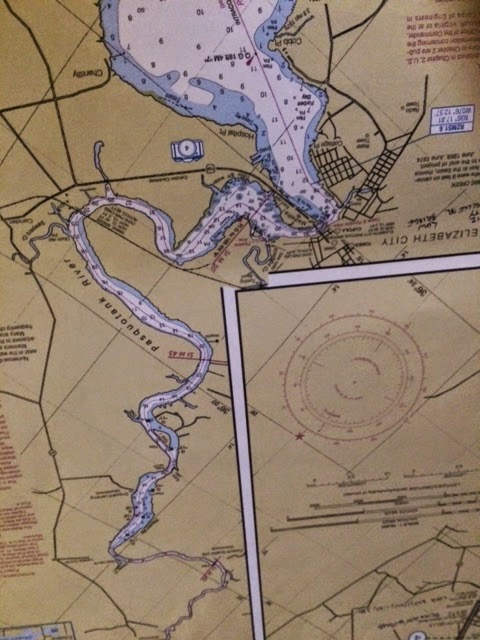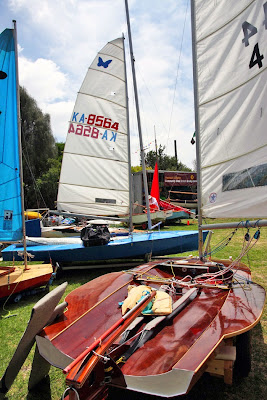Lake Boca is a large rectangle of water cut into the west side of the beach strip of Boca Raton, from the Boca Inlet north for about .4 miles, along the east side of the ICW, .2 miles wide. The center of it is very shallow with only the edges navigable for keel boats. Anchorage for sailboats is in the NE corner. Access to land is in a park with a boat ramp and dinghy dock on the west side of the ICW, just south of the Palmetto Park Boulevard Bridge, north of the lake (less than half a mile away). We will have to request an opening of that bridge when we leave to head north.

Craig had a better idea about where to go ashore, because the tide runs fast under the bridge and big boats go too fast and make wakes: his boat, Sangaris, pictured above, is docked in a canal at the back yard of a private home about a mile further north. He picked us up there and we got to see Sangaris again, after all her European adventures.
 Ive been saying that when I get too old to sail ILENE, a radio controlled sailing boat on a lake may be in my future. Well Kathy had to work, Lene did her phone work from Kathy and Craigs house, and Craig took me to another gated community a bit further north called Kings Point, which has a lake in which his club races such boats. Beauties, one meter long, high aspect ratio,with 3/4 of the weight in the keel. The control box is worn on a strap around ones neck and the right thumb controls the rudder by pushing its joy stick left of right, while the left thumb controls both sails with back to pull them closer hauled and forward letting them fly for the downwind legs of the course. Below is Craig, demonstrating and Erwin, also a Past Commodore of the Harlem and racer, to the right.
Ive been saying that when I get too old to sail ILENE, a radio controlled sailing boat on a lake may be in my future. Well Kathy had to work, Lene did her phone work from Kathy and Craigs house, and Craig took me to another gated community a bit further north called Kings Point, which has a lake in which his club races such boats. Beauties, one meter long, high aspect ratio,with 3/4 of the weight in the keel. The control box is worn on a strap around ones neck and the right thumb controls the rudder by pushing its joy stick left of right, while the left thumb controls both sails with back to pull them closer hauled and forward letting them fly for the downwind legs of the course. Below is Craig, demonstrating and Erwin, also a Past Commodore of the Harlem and racer, to the right.
 All I can say is that it is a lot harder than it looks and I lost every race; actually I did not finish them. When aboard a boat you can easily see if your bow is pointed to the right or left of a buoy; you feel the tension of the water on the rudder; you can see how close to the wind you are. But offset by 50 to 100 yards and at a strange angle, these critical facts are not readily apparent at least not yet, to me. And rudder control is maintained by constant pressure of perhaps a half inch on the "tiller". But these things can be learned and the fifteen guys had a good camraderie going. Kathy is one of the guys and quite competitive when she is not working. I raced her boat, number 3. Erwin brought some beer for the "after". We plan to see Erwin again before heading north.
All I can say is that it is a lot harder than it looks and I lost every race; actually I did not finish them. When aboard a boat you can easily see if your bow is pointed to the right or left of a buoy; you feel the tension of the water on the rudder; you can see how close to the wind you are. But offset by 50 to 100 yards and at a strange angle, these critical facts are not readily apparent at least not yet, to me. And rudder control is maintained by constant pressure of perhaps a half inch on the "tiller". But these things can be learned and the fifteen guys had a good camraderie going. Kathy is one of the guys and quite competitive when she is not working. I raced her boat, number 3. Erwin brought some beer for the "after". We plan to see Erwin again before heading north.
And in the evening we had dinner with not just Craig and Kathy, but also Mike and Janet. The latter have a Florida home and we will see them again at their home in St. Michaels, off the Chesapeake on Marylands Eastern Shore, on our way home. I forget to take their picture but they are pictured from when we visited them in the Chesapeake in 2012 if you want to take a look. A nice Greek restaurant.
We rented a car for one day for trips to cousin Naomi to pick up a late arriving bundle of mail from home, the pet food store, Publix, the automotive store for things for the dink, the post office, the bank and the beach.
 On our last day we toured around Mizener Village, which is a ritzy shopping mall. I got some new shorts because none of my old ones are unstained. We had lunch out and saw The Second Best Exotic Marigold Hotel, which celebrates India and aging. Good but not as good as the first movie. The theater is called Ipic and does not really want to be in the movie business. Seats are very large and comfortable and $14 if you want to sit in the first two rows, or $24 if you want even more luxurious seats with free use of a pillow and blanket and free popcorn. And Ipic has a full service restaurant and bar that you can patronize before or after and provides delivery of food and drink to your seat during the movie. And no reduced rate for matinees or for seniors. The staff said it is a "good place to impress your date on a special occasion". The film is apparently just a gimmick to get folks to come in and spend money on the "entertainment experience package". This hustle offends me and I hope it fails, though we were the only two in the sixteen "cheap" seats while perhaps ten people sat behind us. We have had nice warm dry calm weather while in Boca. Next stop: Palm Beach.
On our last day we toured around Mizener Village, which is a ritzy shopping mall. I got some new shorts because none of my old ones are unstained. We had lunch out and saw The Second Best Exotic Marigold Hotel, which celebrates India and aging. Good but not as good as the first movie. The theater is called Ipic and does not really want to be in the movie business. Seats are very large and comfortable and $14 if you want to sit in the first two rows, or $24 if you want even more luxurious seats with free use of a pillow and blanket and free popcorn. And Ipic has a full service restaurant and bar that you can patronize before or after and provides delivery of food and drink to your seat during the movie. And no reduced rate for matinees or for seniors. The staff said it is a "good place to impress your date on a special occasion". The film is apparently just a gimmick to get folks to come in and spend money on the "entertainment experience package". This hustle offends me and I hope it fails, though we were the only two in the sixteen "cheap" seats while perhaps ten people sat behind us. We have had nice warm dry calm weather while in Boca. Next stop: Palm Beach.
Read More..

Craig had a better idea about where to go ashore, because the tide runs fast under the bridge and big boats go too fast and make wakes: his boat, Sangaris, pictured above, is docked in a canal at the back yard of a private home about a mile further north. He picked us up there and we got to see Sangaris again, after all her European adventures.


And in the evening we had dinner with not just Craig and Kathy, but also Mike and Janet. The latter have a Florida home and we will see them again at their home in St. Michaels, off the Chesapeake on Marylands Eastern Shore, on our way home. I forget to take their picture but they are pictured from when we visited them in the Chesapeake in 2012 if you want to take a look. A nice Greek restaurant.
We rented a car for one day for trips to cousin Naomi to pick up a late arriving bundle of mail from home, the pet food store, Publix, the automotive store for things for the dink, the post office, the bank and the beach.
















































